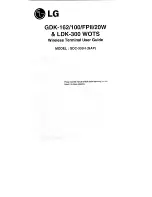
17
© 2000 Motorola, Inc.
THEORY OF OPERA-
TION
Theory of Operation
Reciever Circuitry
RF enters the phone via the internal antenna, A1, or
via the accessory connector. RF switch U75 selects
which antenna is used. The received RF signal is
routed through monoblock duplex filter FL75. Then
the RF signal is routed through RF switches U100,
then thru FL100 and FL101 into U150-LNA. In
CDMA Mode LNA-turns on or off based on the
incomming signal strength. The received signal then
enters the Mixer U200.
The local oscillator input to the mixer is a 978-1004
MHz VCO, U626 controlled by the IF/Synthesizer IC
U700. The two mixer output is routed to separate
paths for AMPS 109.65MHz and 109.8 MHz for
CDMA is routed seperately. The IF during Amps
mode (109.65MHZ)is routed through IF band pass fil-
ter FL250 into ZIF syn IC -U700. The IF during
CDMA Mode (109.8MHz) is routed through IF band
pass filter FL251 and through Q251 into ZIF syn IC -
U700.
Transmitter Circuitry
The modulated TX Offset VCO signal is mixed with-
the 978-1004 MHz local oscil-lator signal in TX
Mixer U400 to produce an 823-849 MHz transmit sig-
nal. This signal passes through filter FL400 and volt-
age controlled attenuator U400 which controls the TX
output power. Then the TX signal is amplified by
U530 and passes through Tx detect circuit. The output
passes through the mono-block duplex filter FL75 to
RF switch U75 to either the internal antenna or the
accessory connector.
Frequency Synthesizer Circuitry
The phone contains three PLL frequency synthesizers
in the IF/Synthesizer IC U700. One synthesizer con-
trols the tunable 978- 1004 MHz main local oscillator,
U626. The second synthesizer controls the TX offset
oscillator (internal to U700) which operates at a fixed
frequency of 309.3 MHz for AMPS, and 309.6 MHz
for CDMA. The TX offset signal is divided by 2
before going to the TX mixer. TX modulation occurs
in the TX offset
synthesizer in both AMPS and CDMA modes. The
third synthesizer (also internal to U700) operates at a
fixed frequency of 219.3 MHz for AMPS, 219.8 MHz
for CDMA. This oscillator is divided by 2 and
used to mix the received first IF signal down to base-
band. All synthesizers obtain their frequency refer-
ence from the 16.8 MHz reference oscillator, U325.
Transmit Power Control Circuitry
The power control signal controls voltage
controlled attenuator U400 which is the TX mixer. A
detected sample of the TX output signal with a vari-
able reference voltage. A closed loop adjusts the
Power Control signal such that the sampled RF signal
level matches the reference level. In AMPS mode, the
RF power range is +8 dBm to +28 dBM. In CDMA
mode the RF power range is -50 dBm to +24 dBm. In
CDMA mode, the power control can operate in either
open-loop or closed-loop modes. In open-loop mode,
the power level is proportional to the received signal
level. In closed loop mode, the power level is con-
trolled by the CDMA cell, based on received signal
strength at the cell site.
Receive Audio - AMPS Mode
AMPS discriminator audio is routed to CIA-IC to be
digitized. All receive audio filtering and gain control
is performed in the digital domain by DSP in casper.
The processed RX audio is converted back to analog
by CIA ICand amplified by the CCAP Lite. The
received audio is then routed to either the internal ear-
Summary of Contents for V8162
Page 1: ...CDMA V8160 Service Manual Level III DIGITAL WIRELESS TELEPHONE series ...
Page 2: ...CDMA V8160 ...
Page 4: ...CDMA V8160 ...
Page 19: ...Troubleshooting RFBlock Diagram ...
Page 20: ...V8160 Audio Logic Side Block Diagram ...
Page 42: ...V8160 ...
Page 50: ...V8160 ...
Page 58: ...V8160 ...
Page 73: ...Replacement Parts ...
Page 74: ...V8160 ...
Page 75: ...Replacement Parts ...
Page 76: ...V8160 ...
Page 78: ...V8160 P8 5 Bo Page CDMA V8160 Antenna Circuit ...
Page 79: ...79 2000 Motorola Inc REPLACEMENT PARTS V8160 V8162 ...
Page 83: ...83 2000 Motorola Inc REPLACEMENT PARTS V8160 V8162 ...
Page 84: ...84 2000 Motorola Inc REPLACEMENT PARTS V8160 V8162 ...
Page 86: ...V8160 V8162 ...
Page 87: ...Replacement Parts ...
Page 88: ...V8160 V8162 ...
Page 89: ...Replacement Parts ...
Page 90: ...V8160 V8162 ...
Page 91: ...Replacement Parts ...
Page 92: ...V8160 ...
Page 93: ...Replacement Parts ...
















































